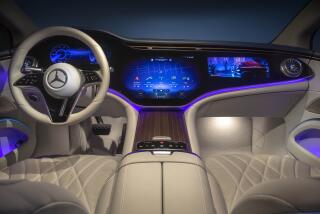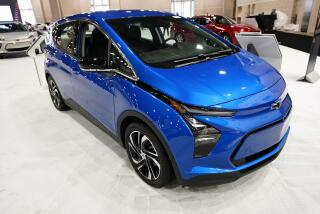SUVs Improve in Rollover Testing
WASHINGTON — Sport utility vehicles are making strides to avoid rollovers, the government says, noting that 7 in 10 new SUVs are equipped with rollover-reducing electronic stability control.
The National Highway Traffic Safety Administration released rollover results for 2006 vehicles Tuesday, finding that 39 SUVs earned four-star ratings. SUVs have shown steady improvements in the testing; two dozen SUVs received four stars last year and only one SUV tested that well in 2001.
No SUV earned a top, five-star rating.
The results -- available at www.safercar.gov -- are used by consumers to assess a vehicle’s ability to reduce rollovers, which kill more than 10,000 motorists in the United States annually.
Electronic stability control is an anti-rollover system in which brakes are automatically applied when the vehicle begins skidding, helping to steady the vehicle.
The government’s traffic safety agency said 69% of all SUVs from the 2006 model year offered the technology as standard equipment, a significant jump from 43% of 2005 SUVs with standard stability control.
Newly tested SUVs that received four stars included the Chevrolet HHR, the Honda Pilot, the Toyota RAV4, the Subaru B9 Tribeca, the Hyundai Tucson, the Mercedes-Benz ML Class, the Suzuki Grand Vitara and 4x4 versions of the Chevrolet TrailBlazer.
Among top-scoring SUVs, the HHR had a 14% chance of rollover and 4x4 versions of the Pilot had a 15% chance of rollover.
The 4x4 version of the Nissan XTerra had a 25% chance of rollover, the highest percentage among the new SUVs tested. The 4x2 version of the XTerra, the 4x2 Chevrolet Tahoe and Hummer H3 had a 24% chance of rollover. Those vehicles received three stars.
Among passenger cars, the Pontiac G6 and the Buick Lucerne were the only vehicles to receive five stars.
The eight-passenger Chevrolet Express 1500 van was the only new vehicle that tipped over in testing; it received three stars and had a 28% chance of rollover. General Motors Corp. spokesman Alan Adler said 2007 versions of the van would have stability control as a standard feature.
The Ford E350 XLT Super Duty van received two stars and had a 30% chance of rollover. Ford spokesman Dan Jarvis said the van was safe, and he noted that some of its ratings were derived from the vehicle’s dimensions.
Jarvis said the wheels stayed on the ground during similar internal testing.
“We think that should be a true measure of a star rating,” he said.
Under the ratings system, a vehicle with five stars has a rollover risk of less than 10% and a four-star vehicle has a 10% to 20% risk. Three-star vehicles have a 20% to 30% risk.
Government studies have found stability control reduces single-vehicle sport utility crashes by 67% and one-car crashes by 35% compared with the same models sold in previous years without the technology.
NHTSA is expected to issue a proposal this year specifying a performance criteria for stability control.
Robert Strassburger, the Alliance of Automobile Manufacturers’ vice president of safety, said automakers had aggressively implemented the technology into vehicles because it saved an estimated 6,000 to 7,000 lives a year.






